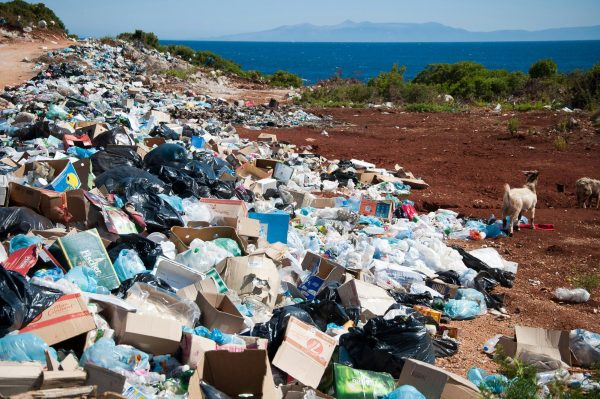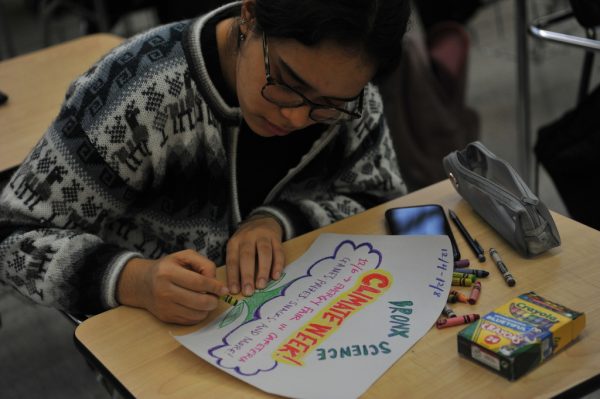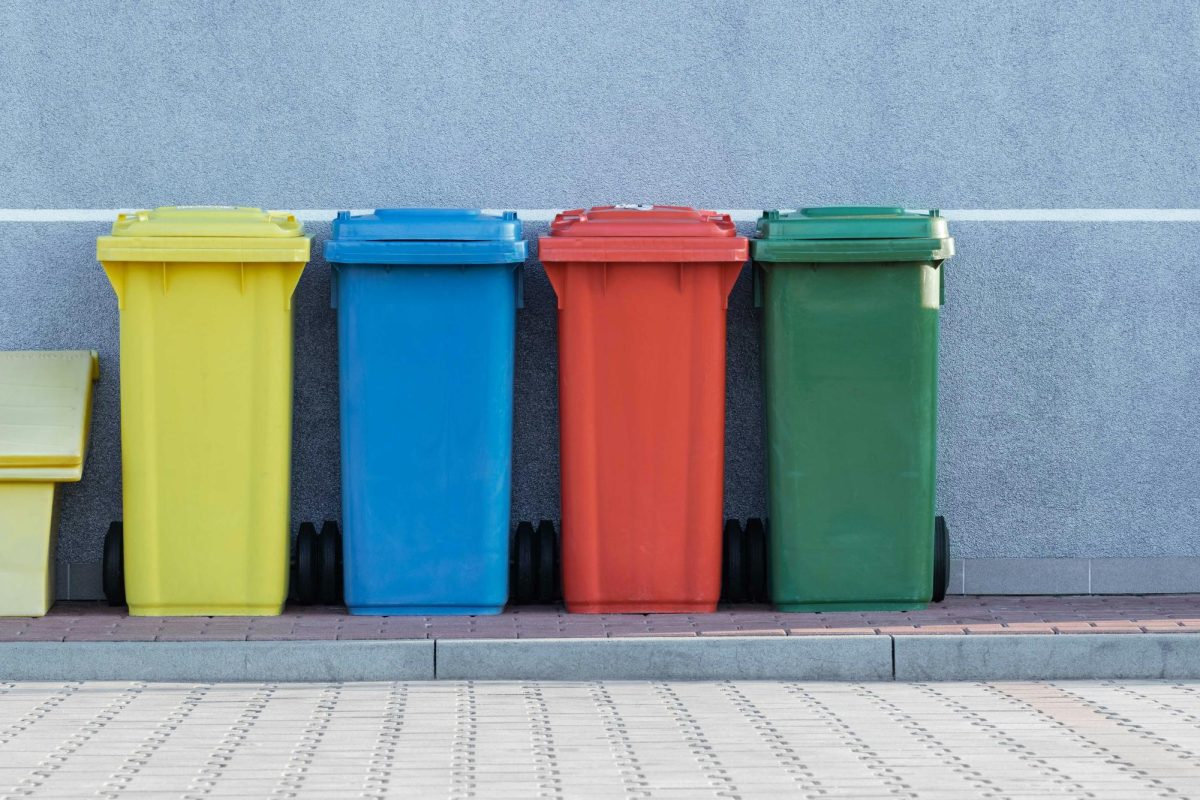During this bustling day and age of our lives, it’s easy to overlook the footprint we leave behind with our consumption habits. But have you ever wondered about the environmental and social impact of a single day’s worth of waste? From the moment we wake up to the time we go to bed, every choice we make contributes to the waste stream.
Globally, one person creates around 1.63 pounds of trash; however, according to the NYS Department of Environmental Conservation, the average American creates more than 4.5 pounds of trash each day. A normal size bag of Gold Medal All Purpose Flour weighs 5 pounds, and it is pretty heavy, so what do we consume in a day to create more than 4.5 pounds a day on average?
The top three categories that populate the U.S. landfills are food waste, plastic, and paper and paperboard. These can all be recycled or composted, but often are not because they are thrown in the wrong bin, causing large amounts of waste to be dumped in landfills instead of recycling centers or commercial composting facilities.
Packaging is a huge factor of waste. The convenience-driven culture of grab-and-go lifestyles has given rise to a reliance on disposable packaging, from plastic containers to cardboard boxes. This packaging predicament extends beyond the disposal phase, as the production and transportation of packaging materials also contribute to carbon emissions and resource depletion. Every step connects in this capitalistic world where businesses want to make profits and firms will continue to pack and ship goods.
More frustratingly, in 2018, according to the Environmental Protection Agency, the U.S. generated 292.4 million tons of garbage. An astonishing 21.59 percent of that was wasted food. Several factors contribute to food waste, including overbuying food, the overproduction of retail products or crops, and improper food storage. Food being wasted is a heartbreaking fact to read about, as many people in the world are still enduring hunger issues and food insecurity. According to the World Health Organization, as many as 828 million people were affected by hunger in 2021.
Negative Consequences
Every 15.5 hours, Americans throw out enough plastic to fill the AT&T Stadium. Part of this problem can be attributed to a general ignorance of plastics; most people do not know what types of plastics there are and which types can be recycled. According to the National Academies of Sciences, Engineering, and Medicine, only around 10 percent of plastics in the United States are recycled.
However, sometimes producers take the blame. Many plastics have no resin code or recycling symbol on the packages to tell us which category it is from, making it difficult to know if they are recyclable or not. However, even if we start recycling, it wouldn’t matter, as most plastics can’t be recycled anyway. Soft wraps and films, sometimes called “No. 4 plastics,” are not widely accepted in curbside collections. Plastics don’t biodegrade like other materials. Instead, they linger in the environment for centuries, transforming into microplastics that get in our soil, our water, and even our own bodies.
Because most plastic items cannot be recycled, they end up in landfills. Landfills release methane and numerous other toxic gasses that absorb heat and contribute to climate change. Other than enhancing global warming, it decreases biodiversity as more land is cleared to make landfills, leading to habitat loss and degradation. Leachate can be produced from landfills as well, which contaminates nearby water sources that organisms rely on for survival.

Zero-Waste Movement
The Zero-Waste Movement promotes the reduction, reuse, and recycling of any waste we create and conservation programs focused on minimizing waste generation, promoting responsible consumption, and ensuring the long-term health of ecosystems. It emphasizes sustainability, which goes beyond the 3 R’s. The United Nations Brundtland Commission defined sustainable as “meeting the needs of the present without compromising the ability of future generations to meet their own needs.”
Lauren Singer, an environmental activist, aims to reduce her waste to zero and prove to the public that it is possible to do so. In 2016, there was a rise in media covering fitting trash in a mason jar after Singer’s YouTube video about how she was able to fit five years of her trash in one mason jar, which symbolizes the zero-waste movement. Many people find the notion to be unrealistic and believe there are more practical ways to be environmentally friendly, such as focusing on plastic/packaging reduction.
The mason jar includes saran wrap, plastic stickers, produce stickers, credit card, plastic price tag holder, and other small unrecyclable plastics that weren’t currently recyclable in New York City recycling programs from 2012-2016. She was also able to utilize composting to eliminate food wastes and get food/produce without packaging. Whether every single piece of waste was included in the jar is difficult to verify, but the intention was to showcase a significant reduction in waste through conscious choices.
In an interview with CNN, Singer said, “I’ve changed my lifestyle and prevented thousands of pounds of trash going to landfill. I believe that one person can make a difference, it’s just having a desire to do so.” Singer tries to send the message that if everyone manages their trash and consumption, it will be easier to make the environment green.
Bronx Science Composting Program
But what can we do as students? Bronx Science has a composting program in which the Green Team partnered with an organization called GrowNYC during the 2022-2023 school year to bring a composting initiative to the cafeteria and classrooms. It focuses on educating the student body on how to differentiate their food waste and knowing which products on their lunch tray go into which bin.
Jessy Liu ’24, the President of the Bronx Science Green Team, said, “The primary purpose is to get students to recognize that their food scraps, the lunch tray, and even the utensils are all compostable and should be placed into the brown composting bins. The success of the program truly lies with the student body actually participating in and learning from the program and its volunteers.”
Now, during every lunch period, there are volunteers from the National Honor Society helping the Green Team facilitate these stations so the food and utensils are being thrown in the correct bin.
“I think the program is a good initiative, and will encourage students to think before they take even small actions, such as throwing away their food scraps and utensils. I hope that the program will encourage students to volunteer and be more involved in the ‘greener Earth effort’ outside of the school environment,” said Tasneem Meem ’24, who often volunteers during her lunch period.
Liu has a positive attitude toward the growth of the composting program and youth action. She said, “With the right attitude, determination, and motivation, I am confident that we as a school can be at the forefront of addressing the growing sustainability concerns and creating a happier, healthier, and greener world.”
She herself can confidently say that her daily trash can fit into a 16 ounce mason jar, as she is conscious about how much food is remaining and whether or notit can be reserved as leftovers or thrown away. On a daily basis, she produces some wrappers from snacks, tissue papers, plastic bottles, and sometimes labels/tags from shopping.

Future Steps
Everyone has a role to play in the future of our planet. Many companies are already shifting toward more sustainable goals: Nike’s Move To Zero Sustainability goal, for example, is to reuse, recycle, and repurpose existing materials and ultimately recycle at least 80% of waste produced. However, there is also the rise of fast fashion leaders such as SHEIN that encourage customers to buy more products that are lower priced but don’t last long. There has been a push to boycott these fast fashion companies because of the environmental impact they have, but also the unethical working conditions and low wages their workers deal with.
Going environmentally friendly doesn’t always mean going completely vegan or cutting out all plastic products completely (it doesn’t sound realistic and achievable for many), and it is not always expensive. Consumers can do their bit by buying recycled products, buying fewer items, and reusing more. It is the small steps that everyone can do for the world that matter. Don’t buy more than you can consume, and compost any food scraps that cannot be consumed. Switch to eco-friendly alternatives such as bamboo toothbrushes and refillable soap dispensers. Opt for package-free products or those with minimal packaging to minimize waste. You can even create your own natural cleaning solutions, personal care items, or even fashion accessories instead of buying them. There are so many ways for us to stay environmentally friendly and small individual actions are significant and can make a change in this battle.
Jessy Liu ’24, the President of the Bronx Science Green Team, has a positive attitude toward the growth of the composting program and youth action. She said, “With the right attitude, determination, and motivation, I am confident that we as a school can be at the forefront of addressing the growing sustainability concerns and creating a happier, healthier, and greener world.”

